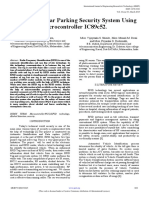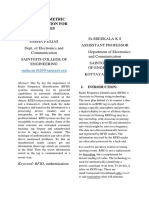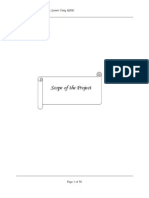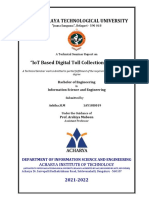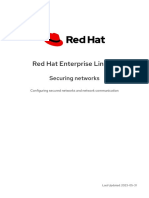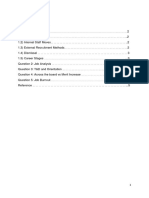Smart Traffic Management System Using Internet of Things: Sabeen Javaid, Ali Sufian, Saima Pervaiz, Mehak Tanveer
Smart Traffic Management System Using Internet of Things: Sabeen Javaid, Ali Sufian, Saima Pervaiz, Mehak Tanveer
Uploaded by
sabithaCopyright:
Available Formats
Smart Traffic Management System Using Internet of Things: Sabeen Javaid, Ali Sufian, Saima Pervaiz, Mehak Tanveer
Smart Traffic Management System Using Internet of Things: Sabeen Javaid, Ali Sufian, Saima Pervaiz, Mehak Tanveer
Uploaded by
sabithaOriginal Description:
Original Title
Copyright
Available Formats
Share this document
Did you find this document useful?
Is this content inappropriate?
Copyright:
Available Formats
Smart Traffic Management System Using Internet of Things: Sabeen Javaid, Ali Sufian, Saima Pervaiz, Mehak Tanveer
Smart Traffic Management System Using Internet of Things: Sabeen Javaid, Ali Sufian, Saima Pervaiz, Mehak Tanveer
Uploaded by
sabithaCopyright:
Available Formats
International Conference on Advanced Communications Technology(ICACT) 393
Smart Traffic Management System Using
Internet of Things
Sabeen Javaid*, Ali Sufian**, Saima Pervaiz**, Mehak Tanveer**
* Department of Computer Software Engineering, College of Telecommunication Engineering, National University of Sciences
and Technology, Islamabad, Pakistan.
** Department of Software Engineering, University of Gujrat, Sialkot Campus, Sialkot, Pakistan.
sabeen@mcs.edu.pk, ali.21311116@uogsialkot.edu.pk, saima.21311005@uogsialkot.edu.pk, mehak.21311003@uogsialkot.edu.pk
Abstract— Traffic management system is considered as one of the systems. The paradigm of the Internet of Thing (IoT) has been
major dimensions of a smart city. With the rapid growth of introduced in traffic management systems [8].
population and urban mobility in metropolitan cities, traffic To the best of our knowledge, it is identified that till date the
congestion is often seen on roads. To tackle various issues for current traffic management systems are centralized. In case of
managing traffic on roads and to help authorities in proper
networking issues, such systems may crash. In addition, there
planning, a smart traffic management system using the Internet of
Things (IoT) is proposed in this paper. A hybrid approach is less focus on fluctuations in traffic flow. Therefore, the
(combination of centralized and decentralized) is used to optimize proposed system manages the traffic on local and centralized
traffic flow on roads and an algorithm is devised to manage servers by exploiting the concepts of IoT and Artificial
various traffic situations efficiently. For this purpose, the system Intelligence together. The representation of traffic data in
takes traffic density as input from a) cameras b) and sensors, then statistical form can also be helpful to authorities for real-time
manages traffic signals. Another algorithm based on Artificial controlling and managing traffic. Moreover, it may also be
Intelligence is used to predict the traffic density for future to helpful for future planning.
minimize the traffic congestion. Besides this, RFIDs are also used The rest of the paper is structured in four sections. Section II
to prioritize the emergency vehicles such as ambulances and fire
discusses the state of the art. The proposed system is presented
brigade vehicles during a traffic jam. In case of fire on the road,
Smoke sensors are also part of this system to detect this situation. and discussed in Section III whereas a discussion on results is
To demonstrate the effectiveness of the proposed traffic being carried on in Section IV. Section V concludes the
management system, a prototype is developed which not only research.
optimizes the flow of traffic but also connects nearby rescue II. LITERATURE REVIEW
departments with a centralized server. Moreover, it also extracts
useful information presented in graphical formats that may help A smart traffic management system that is partially
the authorities in future road planning. deployed in Cambridge city where queue detectors are buried
in the roads that detect the traffic queue and inform the central
Keywords— IoT, Smart City, Smart Traffic Management, Traffic control unit which takes decision accordingly. Since the system
Congestion, Traffic Signal Management. is centralized that can slow down due to networking issues [9].
The researcher used surveillance cameras to detect traffic and
I. INTRODUCTION
OCR to identify the vehicles through number plate recognition
A city is a complex system which consists of many which is a simple detection method but the system will fail in
interdependent subsystems where traffic system is one of its Pakistan as there are different kinds of traffic including cycles,
important subsystems. A study says; it is the cornerstone of the donkey carts which have no number plate [10].
world’s economy [1]. Moreover, it is also declared as one of the Osman et al. proposed a system in which they have used
major dimensions of the smart city [2]. With the rapid growth surveillance cameras to detect traffic density using MATLAB,
of the population of the world, the number of vehicles on a traffic controller and a wireless transmitter used to send
roadways is increasing consequently, the rate of traffic jams is images to the server after that server calculated traffic density
also increasing in the same manner [3] [4]. Traffic jams are not by using those images of every section. This system used fixed
just wasting time but in some cases, it is witnessed that criminal (predefined) thresholds that depend on a number of vehicles on
activities like mobile snatching at traffic signals also happen in road. An algorithm was used to set a time span of red light for
metropolitan cities [5]. On the other hand, it is not only a particular lane of the intersection, which is determined by
affecting ecosystem badly [6] but the efficiency of industries is traffic density on road and forwarded to the microcontroller and
also being affected [7]. then server [11].
It is, therefore, identified that active traffic management is a Jadhav et al. used surveillance cameras, MATLAB and KEIL
necessity. In majority countries, traffic is managed through (Microcontroller coding) to control traffic congestion. This
fixed time signals whereas, in large cities of some developed paper also discusses the priority-based traffic clearance and red
countries, traffic is managed through centrally controlled
ISBN 979-11-88428-01-4 ICACT2018 February 11 ~ 14, 2018
International Conference on Advanced Communications Technology(ICACT) 394
signal broker (Number plate detection). Due to using heavy III. PROPOSED SYSTEM
hardware, it is difficult to manage and become costly [8].
Bui et al. Analyzed a real-time process synchronization based The proposed system, shown in Figure 1, is designed to govern
system to manage the traffic flow dynamically. Sensors were traffic at road networks, sensing through sensors, surveillance
used to detect the traffic, where vehicle to vehicle and vehicle cameras, and RFIDs which are embedded on roadsides. The
to infrastructure communication was done by using wireless system works in a distributed manner, it processes sensors’ data
communication devices. Controller placed at the center of the at the node level and videos’ data at the local server, calculates
intersection received vehicles’ and pedestrians’ information cumulative density to regulate the traffic according to density.
and requests and process using first come first serve method In addition to this, it also tackles emergency vehicles such as
[12]. ambulance, fire brigade. it also helps the users to know the
Swathi et al. proposed smart traffic routing system that chooses congestion status at a road through prediction. The system is
the shortest route having the least congestion. Sensors are used divided into three layers. A) Data Acquisition and Collection
to collect data about traffic density, these sensors use solar layer. B) Data Processing and Decision-making layer C)
energy and battery. ௗSensors kept transmitting infrared light and Application and Actuation layer.
when an object came near, they detect traffic density by A. Data Acquisition and Collection Layer
monitoring the reflected light from the vehicle. However,
readings may change with the change in temperature and Several ways of traffic detection have been used by the
humidity [13]. researchers in the state of the art which consists ultrasonic
Al-Sakran et al. proposed a system in which major goals were sensors, RFIDs, surveillance cameras and light beam. All these
detecting vehicles and get their location by using sensors and sources have merits as well as demerits; the suitable sources in
RFIDs after getting data it sent to centralized controlling center the context of the proposed system are surveillance cameras,
by using a wireless connection for further processing. ultrasonic sensors, RFIDs, smoke sensors and flame sensors.
Researchers used cloud computing, RFIDs, GPS, wireless A surveillance camera is the most widely used source to detect
sensor network (WSN), agent and other modern tools and the road traffic in this field due to efficiency and ease of
technologies to collect, store, manage and supervise traffic maintenance [15] [16] [17] [18]. Blob detection algorithm is
information [14]. applied to the video stream at the local server due to its
performance and capability of noise reduction [18]. After
traffic detection, a local server sends the density measured
through image processing to the respective microcontroller.
Figure 1. The System Model
ISBN 979-11-88428-01-4 ICACT2018 February 11 ~ 14, 2018
International Conference on Advanced Communications Technology(ICACT) 395
σଷୀଵሺܲ݅ሻ = Pi + Pi+1 + Pi+2
Apart from the cameras, this system is also using ultrasonic P is the pair of ultrasonic sensors. Table 1. shows the states of
sensors to enhance the accuracy. Sensors are integral part used the sensors and their results are as follow:
to detect traffic density in many traffic management system
applications [13]. It measures distance by sending out a sound TABLE 1. TRAFFIC DENSITY STATES BY ULTRASONIC SENSORS
wave of a specific frequency and listening for that sound wave
to bounce back. This economical sensor measures the distance Condition /
P1 P2 P3 Status
2 cm to 400 cm [19]. The system calculates the distance by Sensors
using the following formula:
Condition 1 1 0 0 Low
Distance = ((a x b) / 2)
a= Speed of sound Condition 2 1 1 0 Medium
b= time taken
Condition 3 1 1 1 High
As shown in Figure 2, there are three pairs of sensors at a
certain distance are embedded on each roadside of an
intersection to calculate the traffic density. Each sensor’s The microcontroller receives results from sensors and video
reading is 1 or 0 (Either that particular sensor detects the vehicle from a local server to calculate cumulative density using Table
or not). At the node side, density is calculated by considering 2.
the readings of all the sensors embedded at that particular
roadside.
Figure 2. Sensors Network
ISBN 979-11-88428-01-4 ICACT2018 February 11 ~ 14, 2018
International Conference on Advanced Communications Technology(ICACT) 396
TABLE 2. CUMULATIVE DENSITY Time= Į
Sensors’ Camera’s Traffic Part (II) When RFID tags detect emergency vehicle
Situations
Result Result Density
While (vehicle Exits)
Situation 1 High High High Time != 0
Situation 2 High Medium High
Figure 3. Traffic Management Algorithm
Situation 3 High Low Medium
Where Į is regular prefixed time given to a specific roadside,
Situation 4 Medium High High ș=90, x=0, ȕ is extra time added in case of traffic congestion
and Ȗ is extra time added when there is rush interval near to
Situation 5 Medium Medium Medium approach.
Situation 6 Medium Low Medium Moreover, if the emergency vehicle is detected, the system
stops its normal operation and immediately turns the respective
Situation 7 Low High Medium signal green and it remains green until that particular vehicle
passes to that intersection. In addition to this, if the fire is
Situation 8 Low Medium Medium
detected on the road, the microcontroller intimates to the
Low Low Low
respective local server through which it goes to the centralized
Situation 9
server and then this information goes to the respective
department through a mobile application. The flow, how the
B. Data Processing and Decision-Making Layer system calculates signal time, is presented in Figure 4.
The system manages the road traffic according to the
traffic condition. a) In the first situation, each traffic signal has
a preset time that is Į seconds, when there is normal traffic on
road. Every signal is going for green at their turn for Į seconds,
and rest of signals at that time remains red until all remaining
traffic signal at an intersection complete their turn. Traffic ratio
is increasing day by day and our current Fixed-time signal
control system is not working well in this situation, there is a
dire need to add a density based traffic management module
which allocates time dynamically to each lane on the base of
the traffic density, in second part of algorithm when the
capacity of traffic is increased and flow of traffic is not in
routine, the system calculates the level of density according to
Table 2. and update the time ȕ of traffic signal on the basis of
traffic density. further, undergoes to traffic management
algorithm discussed in Figure 3.
Algorithm:
Part(I) When no emergency vehicle detected
if (Traffic Density == high)
if (Rush Interval==Yes)
Time= ((Į ex sinș) + ȕ) + Ȗ
else Figure 4. Flow Chart of Traffic Management System
Time = (Į ex sinș) + (cosș * Ȗ) + ȕ C. Application and Actuation Layer
else In this layer, there are two types of information delivered i)
if (Rush Interval==Yes) duration of a green signal from node to traffic signal and ii)
daily, weekly, monthly and yearly reports to the administration
Time= (Į ex sinș) + Ȗ of smart traffic management system through the web
else application from a centralized server. First of all, the system
calculates rush interval by using Regression Tree algorithm on
ISBN 979-11-88428-01-4 ICACT2018 February 11 ~ 14, 2018
International Conference on Advanced Communications Technology(ICACT) 397
the data saved at the local server and updates this report to the data i.e. number of vehicles passed in a particular time span at
centralized server on the daily basis (after 24 hours). The rush a particular road. The bar graph is representing real-time traffic
interval is the time span of thirty minutes. This report is then data. Different bar graphs based on historical and real-time data
displayed on the web application which is linked to a are being drawn in this application which is helpful for traffic
centralized server which is for the administration of smart department and other related authorities for i) managing traffic
traffic management system, that shows daily, weekly, monthly congestions on roads ii) and future planning.
and yearly graphs of rush intervals for roads. This graphical
information is fruitful for the future road planning and resource
management.
Secondly in the actuation module, whenever the rush interval is
identified, the local server intimates to the respective
microcontroller along with the road id. After receiving the rush
interval intimation, the decision-making module updates the
duration of the green signal to the respective traffic signal.
In this modern era, where time is money and wastage of time
are not affordable, there is a need to know the traffic condition
on the particular road prior to travel on that road by using
mobile application. Moreover, this system is also capable of
managing emergency situations like if the smoke and fire are
detected on the road. In case of fire on the road, which is
detected by flame sensors and extensive smoke through smoke
sensors, the system intimates to the nearby relevant department
through a mobile application for further actions. Figure 6. Statistical data on traffic
IV. RESULTS AND DISCUSSION V. CONCLUSION
A prototype was developed to demonstrate the applicability of This research presents an effective solution for rapid growth of
our proposed system. Several experiments on real traffic data traffic flow particularly in big cities which is increasing day by
were carried out to evaluate the efficiency of the proposed day and traditional systems have some limitations as they fail
algorithm. The traffic density was monitored and calculated by to manage current traffic effectively. Keeping in view the state
vehicle detection as shown in Figure 5. As soon as the traffic of the art approach for traffic management systems, a smart
density crosses the specified threshold on a road, the system traffic management system is proposed to control road traffic
stopped the normal operation and kept the green light on till the situations more efficiently and effectively. It changes the signal
situation on the road became normal. The real-time data was timing intelligently according to traffic density on the particular
also being sent to the local and central server as well. roadside and regulates traffic flow by communicating with
local server more effectively than ever before. The
decentralized approach makes it optimized and effective as the
system works even if a local server or centralized server has
crashed. The centralized server communicates the nearest
rescue department in case of an emergency situation which
provides timely human safety. Moreover, a user can ask about
future traffic level at particular road hence avoiding wastage of
time in traffic jams. The system also provides useful
information to higher authorities that can be used in road
planning which helps in optimal usage of resources.
REFERENCES
[1] W. S. Associate, "Transportation and Economy Report," MDOT State
Long Range Transportation Plan, Karachi, 2007.
[2] K. S. D. M. R. B. Patan Rizwan, "Real-Time Smart Traffic Management
System for Smart Cities by Using Internet of Things and Big Data," in
Figure 5. Vehicles Detection
International Conference on Emerging Technological Trends [ICETT],
Kollam, 2016.
Besides this, a web interface was also developed for the
[3] C. S. D. L. T. Authority, "Annual Vehicle Statistics," Annual Vehicle
authorities to show them the statistics of traffic on the roads so Statistics 2015, Karachi, 2015.
that they could make real-time and future decisions as
discussed in section III. Figure 6 shows the statistical traffic
ISBN 979-11-88428-01-4 ICACT2018 February 11 ~ 14, 2018
International Conference on Advanced Communications Technology(ICACT) 398
[4] M. P. a. B. B. Sivasankar, "IoT Based Traffic Monitoring using Ali Sufian, is a Software Engineer. He completed his BS
Raspberry Pi," Internation Journal of Research in Engineering, Science degree in Software Engineering from University of
and Technology (IJRESTs), vol. 1, no. 7, pp. 2454-664x, 2016. Gujrat, Sialkot Campus, Pakistan. He joined IEEE as a
student member in 2014. He served IEEE UOG Sialkot
[5] A. Lone, "Karachi’s crime malaise," Tribune.com.pk, 18 August 2011.
student branch as a chair from 2015-2017. His field of
[Online]. Available: https://blogs.tribune.com.pk/story/7540/karachis-
interests includes Internet of Things and Artificial
crime-malaise/. [Accessed 20 September 2017].
Intelligence.
[6] S. Sharief, "Road Accidents in Pakistan Reach Alarming High: Who’s
Responsible," Pakwheels.com, 2016. [Online]. Available:
https://www.pakwheels.com/blog/alarming-increase-of-road-accidents-
Saima Pervaiz, is a Software Engineer. He completed
in-pakistan/. [Accessed 2017].
her BS degree in Software Engineering from University
[7] B. k. Khan, "Traffic jams in Karachi result in losses worth of millions of Gujrat, Sialkot Campus, Pakistan. She joined IEEE as
each day," PakWheels.com, 2013. [Online]. Available: a student member in 2014. Her field of interests includes
https://www.pakwheels.com/blog/traffic-jams-karachi-result-losses- Internet of Things, Web of Things and Artificial
worth-millions-day/. [Accessed 2017]. Intelligence.
[8] P. K. K. P. S. T. Prashant Jadhav, "Smart Traffic Control System Using
Image Processing," International Research Journal of Engineering and
Technology (IRJET), vol. 3, no. 3, pp. 2395-0056, 2016.
Mehak Tanveer, is a Software Engineer. She completed
[9] E. Leigh, "Advancing integrated and sustainable transport for the her BS degree in Software Engineering from University
Cambridge region," Smarter Cambridge Transport, 2017. [Online]. of Gujrat, Sialkot Campus, Pakistan. She joined IEEE as
Available: http://www.smartertransport.uk/. [Accessed 2017]. a student member in 2014. Her field of interests includes
[10] T. C. N. K. Kartikeya Jain, "Smart vehicle identification system using Internet of Things, Web of Things and Artificial
OCR," in 3rd International Conference on Computational Intelligence Intelligence.
& Communication Technology (IEEE-CICT 2017), Ghaziabad, India,
2017.
[11] T. e. a. Osman, "Intelligent traffic management system for a cross section
of roads using computer vision," in Computing and Communication
Workshop and Conference (CCWC), 2017 IEEE 7th Annual, 2017.
[12] D. C. J. E. J. Khac-Hoai Nam Bui, "Real-Time Traffic Flow
Management Based on Inter-Object Communication: a Case Study at
Intersection," in 7th International Conference on Ambient Intelligence
(ISAmI’2016), 2016.
[13] V. S. A. M. S. D. K. K. Swathi, "Traffic Density Control and Accident
Indicator Using WSN," International Journal for Modern Trends in
Science and Technology, vol. 2, no. 4, pp. 2455-3778, 2016.
[14] H. O. Al-Sakran, "Intelligent traffic information system based on the
integration of Internet of Things and Agent technology," International
Journal of Advanced Computer Science and Applications (IJACSA), vol.
6, no. 2, pp. 37-43, 2015.
[15] A. S. Nidhi D. Agrawal, "Intelligent Real Time Traffic Controller Using
Image Processing – A Survey," International Journal of Science and
Research (IJSR) ISSN (Online), vol. 4, no. 4, pp. 2319-7064, 2015.
[16] J. D. D. M. A. M. A. J. Vismay Pandit, "Smart Traffic Control System
Using Image Processing," International Journal of Emerging Trends &
Technology in Computer Science (IJETTCS), vol. 3, no. 1, pp. 2278-
6856, 2014.
[17] D. S. P. S. Y. M. Pranav Maheshwari, "Smart Traffic Optimization," in
3rd International Conference on MOOCs, Innovation and Technology in
Education (MITE), IEEE, 2015.
[18] M. A. M. A. T. R. J. S. A.-M. A. B. Fozia Mehboob, "Automated Vehicle
Density Estimation from Raw Surveillance Videos," in SAI Computing
Conference 2016, London, 2016.
[19] K. B. M. R. M. B. Shubham N. Mahalank, Device to Device Interaction
Analysis in IoT based Smart Traffic Management System: An
Experimental Approach, Symposium on Colossal Data Analysis and
Networking (CDAN), 2016.
Sabeen Javaid, is a PhD scholar in Department of
Computer Software Engineering at Military College of
Signals, National University of Sciences and
Technology (NUST), Islamabad, Pakistan. She holds a
MS degree in Computer Software Engineering from
NUST, Pakistan. She is also an IEEE member. Her
research interests include web services, Collaborative
Networks, Web of Things and Internet of Things.
ISBN 979-11-88428-01-4 ICACT2018 February 11 ~ 14, 2018
You might also like
- Summer Internship Project (Amul India)Document62 pagesSummer Internship Project (Amul India)Yajurv Atmapujya87% (45)
- Toll Plaza DesignDocument7 pagesToll Plaza DesignLawrence MilfordNo ratings yet
- RFID Based Automated Petrol PumpDocument8 pagesRFID Based Automated Petrol PumpPranjul Kushwaha100% (1)
- Arduino Based RFID Controlled Automatic E-TOLL Collection SystemDocument3 pagesArduino Based RFID Controlled Automatic E-TOLL Collection SystemSalmaAliNo ratings yet
- Kavach: Cab Signalling & Automatic Train Protection System for Digital RailwaysFrom EverandKavach: Cab Signalling & Automatic Train Protection System for Digital RailwaysNo ratings yet
- Automated Tollplaza System Using RfidDocument6 pagesAutomated Tollplaza System Using RfiddamodharNo ratings yet
- A Review On Smart Parking Systems in Metropolitan Cities Using IotDocument9 pagesA Review On Smart Parking Systems in Metropolitan Cities Using IotMihir PrajapatiNo ratings yet
- Ositrack - RFID Radio Frequency Identification Catalogue 2006.05Document20 pagesOsitrack - RFID Radio Frequency Identification Catalogue 2006.05Sarah RichardNo ratings yet
- Toll Collection SystemDocument3 pagesToll Collection SystemHet PatelNo ratings yet
- Multibeam Antenne en WebDocument4 pagesMultibeam Antenne en WebRavi KiranNo ratings yet
- Fully Automated Toll Tax Collection Using RF Technology. No Need To Stop Car On Toll GateDocument13 pagesFully Automated Toll Tax Collection Using RF Technology. No Need To Stop Car On Toll GateHimanshu SharmaNo ratings yet
- Electronic Toll Collection SystemDocument4 pagesElectronic Toll Collection SystemvishnuNo ratings yet
- RFID Based Automatic Toll Collection SystemDocument5 pagesRFID Based Automatic Toll Collection SystemRahul SainiNo ratings yet
- Smart Ration Card System Using RFIDDocument3 pagesSmart Ration Card System Using RFIDInternational Journal of Innovations in Engineering and ScienceNo ratings yet
- Electronic Toll Collection (ETC) Offers The Opportunity For Toll Facility Operators ToDocument40 pagesElectronic Toll Collection (ETC) Offers The Opportunity For Toll Facility Operators ToRohit PansareNo ratings yet
- RFID Based Automated Toll Plaza SystemDocument7 pagesRFID Based Automated Toll Plaza SystemHussnain RazaNo ratings yet
- Iot-Based Monitoring System: Car'S ParkingDocument11 pagesIot-Based Monitoring System: Car'S ParkingMarta Marizza DespotovicNo ratings yet
- Rfid Based Car Parking Security System Using Microcontroller Ic89c52 IJERTV4IS031045Document5 pagesRfid Based Car Parking Security System Using Microcontroller Ic89c52 IJERTV4IS031045Tummuri ShanmukNo ratings yet
- Automated Toll Collection SystemDocument3 pagesAutomated Toll Collection SystemInternational Journal of Innovative Science and Research TechnologyNo ratings yet
- Smart Toll Collection System Based On Arduino UNO Controller & ESP8266 Node MCUDocument6 pagesSmart Toll Collection System Based On Arduino UNO Controller & ESP8266 Node MCUIJRASETPublicationsNo ratings yet
- 3D 8x8x8 LED Cube ReportDocument19 pages3D 8x8x8 LED Cube ReportEl ProfessorNo ratings yet
- Digital Data Transmission Through Optical LASERDocument14 pagesDigital Data Transmission Through Optical LASERapi-3695829100% (2)
- Electronic Road PricingDocument10 pagesElectronic Road PricingChakshu Agarwal100% (1)
- Electronic Toll Collection Sysem Based On RfidDocument84 pagesElectronic Toll Collection Sysem Based On Rfidspiromarurthi50% (4)
- Conductor Less Bus Ticketing System Using RFID TechnologyDocument6 pagesConductor Less Bus Ticketing System Using RFID TechnologyIJRASETPublicationsNo ratings yet
- Design and Implementation of Low Cost Automatic Toll Collection System Using RFIDDocument6 pagesDesign and Implementation of Low Cost Automatic Toll Collection System Using RFIDGRD JournalsNo ratings yet
- RFID Based Attendance SystemDocument7 pagesRFID Based Attendance SystemAdvanced Research PublicationsNo ratings yet
- Rfid Access Control SystemDocument16 pagesRfid Access Control SystemManjeet SinghNo ratings yet
- Automated Toll Gate System Using Rfid and ArduinoDocument2 pagesAutomated Toll Gate System Using Rfid and ArduinoBrightchip Technologies100% (1)
- Radio Frequency SystemDocument8 pagesRadio Frequency SystemMAnohar KumarNo ratings yet
- Design of A Low-Power Low-Cost UHF RFID Reader ModDocument10 pagesDesign of A Low-Power Low-Cost UHF RFID Reader ModNikhil ShahNo ratings yet
- Automated Toll Collection System Based On RFID SensorDocument16 pagesAutomated Toll Collection System Based On RFID SensorAnkit SinghNo ratings yet
- Automatic Unauthorized Parking Detector With SMS Notification To OwnerDocument2 pagesAutomatic Unauthorized Parking Detector With SMS Notification To OwnerCrisp50% (2)
- Wireless Data Transmission SAEDocument8 pagesWireless Data Transmission SAESeyton123No ratings yet
- Speed Limit Chapter 1Document21 pagesSpeed Limit Chapter 1kalu chimdiNo ratings yet
- Electronic Toll Collection Report (Apex)Document35 pagesElectronic Toll Collection Report (Apex)ghkpvh2001No ratings yet
- RFID Based Shopping Trolley Project ReportDocument54 pagesRFID Based Shopping Trolley Project Reportakshay100% (7)
- RFID Based Women Security SystemDocument39 pagesRFID Based Women Security SystemDebashishParidaNo ratings yet
- Secure Wireless Data Transmission ReportDocument75 pagesSecure Wireless Data Transmission Reportdeeptrivedi61950% (2)
- Car Park Management Solution - 29aug2022Document11 pagesCar Park Management Solution - 29aug2022garydiazvelardeNo ratings yet
- RFID Based Attendance SystemDocument3 pagesRFID Based Attendance SystemKulbir GodaraNo ratings yet
- The Application of Parallel DSP Architectures To Radar Signal ProcessingDocument7 pagesThe Application of Parallel DSP Architectures To Radar Signal ProcessingphithucNo ratings yet
- RFID Based Car Parking SystemDocument27 pagesRFID Based Car Parking SystemKrishna Kant Sashi100% (3)
- Final ReportDocument26 pagesFinal Reportdishant1992No ratings yet
- Rfid Based Automated Petrol PumpDocument18 pagesRfid Based Automated Petrol PumpPranjul Kushwaha100% (1)
- Secure Symmetric Authentication For Rfid TagsDocument5 pagesSecure Symmetric Authentication For Rfid TagsSneha SajiNo ratings yet
- Vehicle Tracking and Ticketing System (VTTS) Using RFID (Complete Softcopy)Document56 pagesVehicle Tracking and Ticketing System (VTTS) Using RFID (Complete Softcopy)Hari Krishnan MA100% (129)
- Rfid Based Toll Tax System With Vehicle SecurityDocument72 pagesRfid Based Toll Tax System With Vehicle SecurityGopalkrishnan Nadar67% (3)
- Visvesvaraya Technological University: Acharya Institute of TechnologyDocument22 pagesVisvesvaraya Technological University: Acharya Institute of TechnologyAshikahm 08No ratings yet
- Bus Management System Using RfidDocument8 pagesBus Management System Using RfidMohanaprakash EceNo ratings yet
- RFID Based Smart Master Card For Bus Train Metro Ticketing: Hardware SpecificationsDocument2 pagesRFID Based Smart Master Card For Bus Train Metro Ticketing: Hardware SpecificationsRoshan SuvarnaNo ratings yet
- Nternational Ournal of Ngineering Ciences & Esearch EchnologyDocument10 pagesNternational Ournal of Ngineering Ciences & Esearch EchnologyNandaBabiNo ratings yet
- Automatic Car Parking System-1Document75 pagesAutomatic Car Parking System-1Hai DoanNo ratings yet
- Smart Helmet With Accident Avoidance SystemDocument7 pagesSmart Helmet With Accident Avoidance Systemijire publicationNo ratings yet
- Fully Automated Toll Tax Collection Using RF TechnologyDocument6 pagesFully Automated Toll Tax Collection Using RF Technologyaagrawal_48No ratings yet
- IOT Asset Tracking System Using Android ApplicationDocument5 pagesIOT Asset Tracking System Using Android ApplicationBhaskar Rao PNo ratings yet
- Radio Frequency Identification Rfid Technology For CattleDocument2 pagesRadio Frequency Identification Rfid Technology For CattleAlex Luna Heredia100% (1)
- Lavasa A Smart City, Scot Wrighton, MYCity Technology LTDDocument60 pagesLavasa A Smart City, Scot Wrighton, MYCity Technology LTDAbhishek Dutta100% (1)
- RF Based Smart Zone Vehicle Speed Monitoring and Control SystemDocument2 pagesRF Based Smart Zone Vehicle Speed Monitoring and Control Systemieee4mybusinessonlyNo ratings yet
- Impact of RFIDDocument23 pagesImpact of RFIDKaren ShuiNo ratings yet
- Technical Seminar Report SAMPLEDocument25 pagesTechnical Seminar Report SAMPLETarun ChandraNo ratings yet
- Basics of Iot Networking - Part Ii: Dr. Sudip MisraDocument16 pagesBasics of Iot Networking - Part Ii: Dr. Sudip Misraxman100% (1)
- Eee f431 MTNDocument2 pagesEee f431 MTNdubstepoNo ratings yet
- Red Hat Enterprise Linux 9 Securing Networks en UsDocument94 pagesRed Hat Enterprise Linux 9 Securing Networks en Usbent vaderNo ratings yet
- Constitution Why and HowDocument12 pagesConstitution Why and HowAparajitha RajeshNo ratings yet
- Unit 7 Mother NatureDocument15 pagesUnit 7 Mother NatureSainah ManigothNo ratings yet
- HRM2601Document5 pagesHRM2601Andre De BeerNo ratings yet
- Time Base GeneratorDocument3 pagesTime Base Generatorsai kishoreNo ratings yet
- Developing A Line of Inquiry (Chart W Examples)Document2 pagesDeveloping A Line of Inquiry (Chart W Examples)Radha PatelNo ratings yet
- Arguments Manifestoes Day 1 and 2Document28 pagesArguments Manifestoes Day 1 and 2Lea Cabar100% (1)
- Let Reviewer For Biological Science Specialization Practice Test - Set 12Document3 pagesLet Reviewer For Biological Science Specialization Practice Test - Set 12Camille ManaloNo ratings yet
- Devotional Poets M 01 Rag HDocument166 pagesDevotional Poets M 01 Rag HYaminikrishna KariNo ratings yet
- Chemistry of The Elements (2nd Edition)Document14 pagesChemistry of The Elements (2nd Edition)mycomiccityNo ratings yet
- Employee Performance EvaluationDocument6 pagesEmployee Performance Evaluationsoundar rajNo ratings yet
- Open Price Close PriceDocument3 pagesOpen Price Close Priceanita mahajanNo ratings yet
- Biofuels PresentationDocument9 pagesBiofuels Presentationronald100% (1)
- Ai LabDocument6 pagesAi LabVivek SharmaNo ratings yet
- Special Theory of Relativity (Solution)Document5 pagesSpecial Theory of Relativity (Solution)Neeraj MeenaNo ratings yet
- Visual Motifs and Representations of PowDocument4 pagesVisual Motifs and Representations of PowAnna Giralt GrisNo ratings yet
- ORTIZ - AMAZING - (M2 Lesson 2 - Types of Sources - While-Task 2)Document2 pagesORTIZ - AMAZING - (M2 Lesson 2 - Types of Sources - While-Task 2)ace starNo ratings yet
- Physics: DPP - Daily Practice ProblemsDocument3 pagesPhysics: DPP - Daily Practice Problemslalithasaranya018No ratings yet
- VB025 Driver Ign 10 Pines SMDDocument7 pagesVB025 Driver Ign 10 Pines SMDpolnovaNo ratings yet
- Curriculum Vitae: Education QualificationDocument4 pagesCurriculum Vitae: Education QualificationBestun AhmedNo ratings yet
- Study Centre WbcrosDocument85 pagesStudy Centre WbcrosJashaikati High School100% (1)
- Distribution System Restoration With Renewable Resources For Reliability Improvement Under System UncertaintiesDocument4 pagesDistribution System Restoration With Renewable Resources For Reliability Improvement Under System Uncertaintiespriyanshum230825eeNo ratings yet
- BIGTVUser GuideDocument26 pagesBIGTVUser GuideDavis Chandy100% (1)
- Final Notes NCM 100Document4 pagesFinal Notes NCM 100Jasmin CubillasNo ratings yet
- Activity 2 - Moving AveragesDocument4 pagesActivity 2 - Moving AveragesMei MCasNo ratings yet
- Ayurvedic Plants in Brain Disorders The Herbal Hope PDFDocument9 pagesAyurvedic Plants in Brain Disorders The Herbal Hope PDFMukesh Duryodhan HirekhanNo ratings yet
- Horizontal & Vertical Structure For Work Organization: Kukuh Faedlur Rahman 14522125Document4 pagesHorizontal & Vertical Structure For Work Organization: Kukuh Faedlur Rahman 14522125kukuhricardoNo ratings yet

















